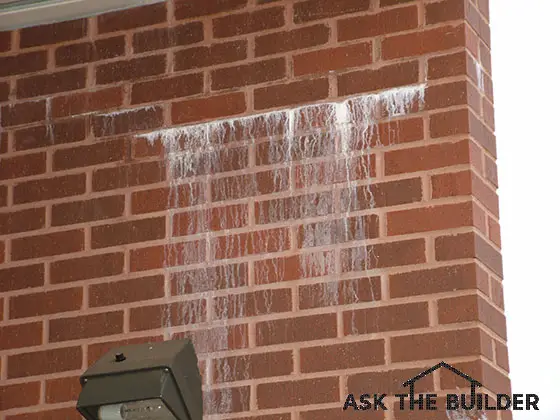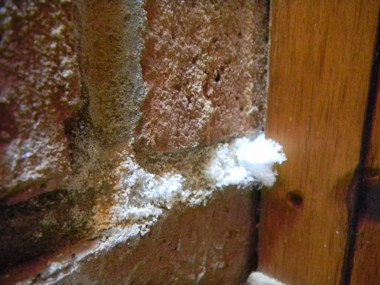Efflorescence on Masonry Surfaces
 Three Ingredients Needed For Efflorescence
Three Ingredients Needed For Efflorescence
Efflorescence requires three primary ingredients in order to occur: availability of water soluble salts; a source of moisture or water to dissolve and transmit the salts; and an environment where the moisture can readily evaporate, thereby depositing the dissolved salts.
Sources of Salts
The efflorescence deposits that you see on your brick or masonry come from many sources. This, of course, often makes it a little tougher to control the problem.
The salts can reside in the masonry units (brick, block, etc.), they may be present in the mortar or cement, the water used to mix the mortar, sand, rain or ground water, soil and backfill dirt, etc.
Moisture Introduction
Efflorescence is not always easy to control. Often it is very difficult to locate the source of moisture or water which is dissolving the salts. Efflorescence on exterior masonry might simply be a result of rain water which soaks into the masonry surface or ground water which is being wicked from the soil into the masonry.
Rain water is often considered to be the primary moisture source for most efflorescence problems. Most masonry will absorb rain water. If a masonry job is improperly constructed, massive amounts of water can be absorbed.
What Happens.....?
For sake of this discussion, let's say that the source of the salts that causes efflorescence is within the bricks. Here is what happens:

Efflorescence growing in the mortar of a brick fireplace. PHOTO CREDIT: Michael Hannum
When the bricks are laid, the bricks absorb moisture from the wet mortar. In certain instances, the bricks may get wet during construction from rain and snow.
Water has a tremendous ability to dissolve things. It can dissolve sugar, salt, medications, soaps, instant iced tea, Kool-Aid, etc. It should come as no surprise that it can dissolve the 'salts' in a brick.
When water enters the brick in our example from any direction (top, bottom, sides, front or back) it begins to dissolve the salts. The salts are now in 'solution' and travel along with the water.
As happens with most brick surfaces, they eventually see a sunny, breezy day. This is the final element needed to deposit the salts on the surface of our sample brick.
What actually happens is quite simple. The sun and wind evaporate the water from the brick.However, only the water makes it into the air. The salts are left behind at the surface.
Interior Efflorescence
Efflorescence on interior plaster work can be a sign that a major problem is beginning to develop.
Water is a primary ingredient in the mechanism of efflorescence. As such, efflorescence on interior plaster surfaces generally indicates that water is either leaking within or into a structure. Most of us do not want water to travel freely through the inside of our structures. The source of this water should be identified and corrected before major structural damage is allowed to occur.
Over the years, I've seen many different spellings of efflorescence. Here's my growing list: effervesce, effervescence, effervescent, effleresants, effloreflance, efflorescence, efflorressance, effluorescence, eflorescence, eflorescents, ellforesce and ifflorescence.
Column B33